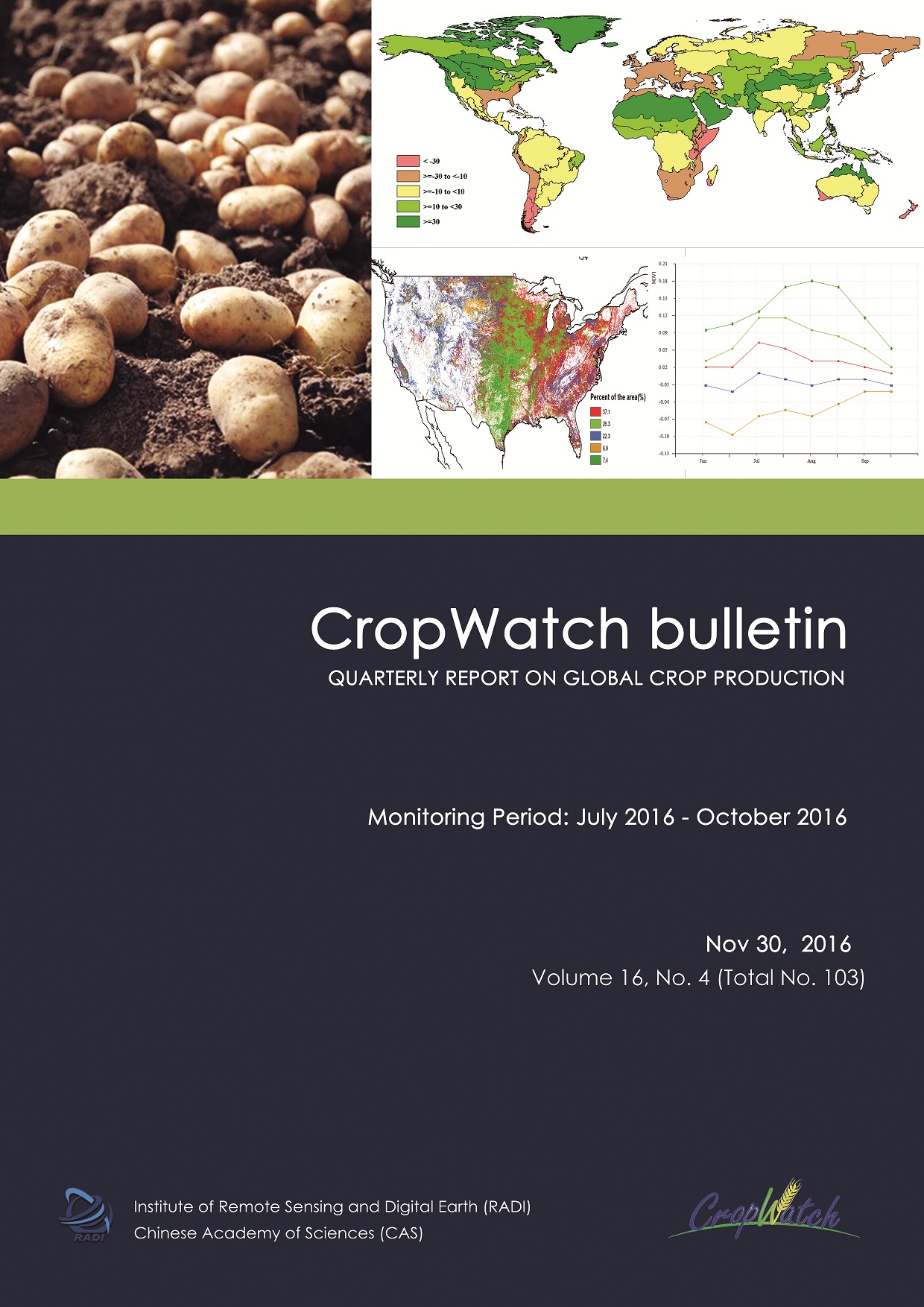
-
November 2016 CropWatch bulletin released. The November 2016 CropWatch bulletin presents the latest CropWatch production estimates for 2016, in addition to the usual updates on prevailing weather conditions, resulting crop condition, and size of cultivated areas, among others, focusing on crop growth from July until the end of October. The bulletin naturally includes detailed analyses for China as well as thirty major agricultural countries; for China, regional conditions and an update on pests and diseases, prices, and prospects for import and export are presented. The geographic focus in this bulletin on the Middle East.
Key messages from the report:
- Global agroclimatic patterns. The reporting period from July to October included several large, coherent areas with weather conditions either favorable or unfavorable to crop production.
- Global crop production in 2016. CropWatch put the total output of crops produced during 2016 at 2,460 million tons of major grains and 316 million tons of soybeans.
- Rice. The early 2016 rice crops did poorly in a number of Asian countries because of the prevailing El Niño drought in Southeast Asia. This includes Cambodia (rice production -10%
- Maize. Maize production increased in Iran (+9%) as well as in a group of countries in Central Asia that benefited from unusually favorable rain for the second consecutive year.
- Wheat. The most spectacular drop in wheat production occurred in Turkey (-17%), followed by some major producers and exporters such as India (-6%), Argentina (-4%), and France and the United Kingdom (both -3%). Large increases are those of Australia (+14%) and Iran (+15%).
- Soybean. Egypt, Iran, Canada, and Argentina all underwent a drop of 1%. Brazil increased production by 2%, while both Russia and the United States improved by 3%.
- China. In China, all crops for 2016 have been harvested, and the total production is put at 200.4 million tons for maize (same as 2015), 200.5 million tons for rice (-1% compared to 2015), 118.6 million tons for wheat (-1%), and 13.3 million tons for soybean (+2%).
- Pests and diseases. In China, rice planthoppers damaged 14.7 million hectares, while rice sheath blight affected a slightly smaller area of 13.3 million hectares.
Introduction
This CropWatch bulletin summarizes global crop condition developments and agroclimatic factors from April 1 to July 30 2016. Chapters 1 through 4 zoom in from a global overview of agroclimatic indicators (Chapter 1) to detailed descriptions of crop and environmental conditions in major production zones (Chapter 2) and individual country analyses covering 30 major producers and exporters (Chapter 3) and China (Chapter 4). A special focus section is included in Chapter 5. This first part of the report includes the cover, table of contents, abbreviations, and a short overview of the different sections of the bulletin.DownloadChapter 1. Global agroclimatic patterns
Chapter 1 describes the CropWatch agroclimatic indicators for rainfall (RAIN), temperature (TEMP), and radiation (RADPAR), along with the agronomic indicator for potential biomass (BIOMSS) for sixty-five global Mapping and Reporting Units (MRU). Indicator values for all MRUs are provided in Annex A.DownloadChapter 2. Crop and environmental conditions in major production zones
Chapter 2 presents the same indicators—RAIN, TEMP, RADPAR, and BIOMSS—used in Chapter 1 and combines them with agronomic indicators—cropped arable land fraction (CALF), maximum vegetation condition index (VCIx), minimum vegetation health index (VHIn), and cropping intensity—to describe crop and environmental conditions in six global major production zones (MPZ). (See also Annex C for more information about these zones.)DownloadChapter 3. Main producing and exporting countries
Building on the global patterns presented in previous chapters, this chapter assesses the situation of crops in 30 key countries that represent the global major producers and exporters or otherwise are of global or CropWatch relevance. In addition, the overview section (3.1) pays attention to all countries worldwide, to provide some spatial and thematic detail to the overall features described in section 1.1. In section 3.2, the CropWatch monitored countries are presented, and for each country maps are included illustrating NDVI-based crop condition development graphs, maximum VCI, and spatial NDVI patterns with associated NDVI profiles. Additional information about the various indicators by country and 2016 production estimates for Argentina, Australia, Brazil, Canada, and the United States are provided in Annexes A and B.DownloadChapter 4. China
Chapter 4 presents a detailed analysis for China, focusing on the seven most productive agro-ecological regions of the east and south: Northeast China, Inner Mongolia, Huanghuaihai, Loess region, Lower Yangtze, Southwest China, and Southern China. After a brief overview of the agroclimatic and agronomic conditions for China over the monitoring period (section 4.1), section 4.2 presents an update on CropWatch estimates for 2016 crop production. Section 4.3 reports on ongoing pest and diseases monitoring, while the next two sections focus on domestic prices (4.4) and grain and soybean imports and exports for the country (4.5). Finally, the analysis for individual regions is provided in section 4.6. Additional information on the agroclimatic indicators for agriculturally important Chinese provinces are listed in table A.11 in Annex A.DownloadChapter 5. Focus and perspectives
Building on the CropWatch analyses presented in other chapters, this chapter includes an updated production outlook for 2016 (section 5.1). Other focus areas are agriculture in the Middle East (5.2) and an update on El Niño (5.3).DownloadAnnex A. Agroclimatic indicators
Tables in this Annex provide additional information about the agroclimatic indicators—RAIN, TEMP, and RADPAR—as well as BIOMSS for the various CropWatch spatial units. Those units include the Monitoring and Reporting Units (MRU); the thirty-one main producing and exporting countries; and regions or provinces within large countries—Argentina, Australia, Brazil, Canada, India, Kazakhstan, Russia, and the United States; and China.DownloadAnnex B. 2016 Production estimates
Annex B includes tables with 2016 production estimates for Argentina, Australia, Brazil, Canada, and the United States.DownloadAnnex C. Quick reference guide to CropWatch indicators, spatial units, and production estimation methodology
Annex C presents a brief overview of the CropWatch indicators and spatial units (including the MRUs, MPZs, and countries), along with a description of the CropWatch production estimation methodology.Download

